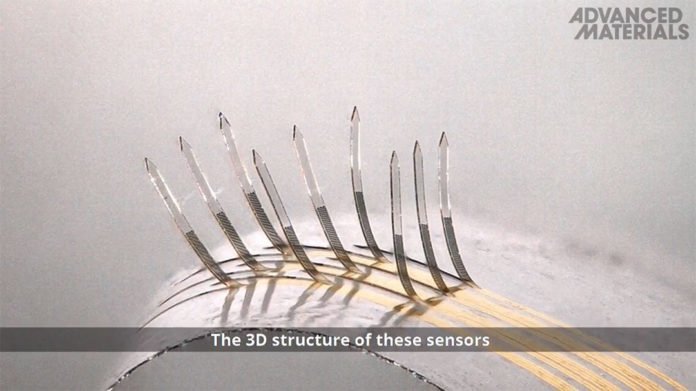Scientists at the University of Texas at Dallas have developed artificial, electronic versions called e-whiskers with hair-like structures.
Jonathan Reeder BS’12, PhD’16, lead author of the study who conducted the research said, “There are some really interesting examples in the animal kingdom of how whiskers are useful for probing and interrogating the environment.”
“Seals use long whiskers for very complex sensing. When they swim in the water, their whiskers actually feel the flow of water as they’re going. Tests have been conducted in which a blindfolded seal will find a fish swimming in the pool and can actually track the fish based on turbulence. The fish disturbs the water, the water disturbs the whiskers of the seal, and that gives it information about where the fish is. It’s the 3D structure of the whiskers that enables these advanced functionalities.”
Outlines of the e-whiskers were cut out from a flat sheet of shape-memory polymer, which is rigid at room temperature but becomes flexible when heated. A flexible strain sensor was patterned on top of each whisker, which had about the same diameter as a human hair and remained attached to the sheet.
At the point when analysts blew hot air through the base of the patterns, the material turned out to be delicate and bendable, permitting the little fingers — or e-whiskers— to rise and wind up three-dimensional. Once the e-whiskers were gathered, unsettling influences actuated changes in the obstruction of the strain sensor that took into account the exact following of every e-whisker position.
Dr. Walter Voit BS’05, MS’06. Voit, an associate professor of materials science and engineering and mechanical engineering said, “We’ve created some of the highest density of e-whiskers to date. When you have a lot of sensors like this that can be dragged over a surface, you can then use them to measure many interesting properties. Our e-whiskers were able to detect force, pressure, proximity, temperature, stiffness and topography. As they brush up against — or whisk across — various materials, they mimic the sensing capabilities of human skin.”
Jonathan Reeder BS’12, PhD’16, lead author of the study said, “Many robots already collect tactile information from their physical environment. However, traditional sensors lack the complexity and richness of human touch. With e-whiskers, we can increase the types of information that can be obtained when grazing a sensor across a surface. In robotics, e-whiskers could replicate the functionalities of human skin by determining what’s hard and soft, hot and cold, smooth and rough. They could allow the robot to identify objects and interact with them safely, making the robots more ‘human-friendly.’”
“Integrating electronic sensors directly with biology is the most compelling application but presents a set of tough challenges. Namely, how to translate electronic signals generated by the sensor into the ‘language’ of the nervous system, and how to form a stable mechanical and electrical coupling between the flexible electronic and the soft tissue.”
“The sensitivity of the e-whiskers to changes in surface topology and temperature, as well as the sensors’ response time, all exceed the capabilities of human skin by at least an order of magnitude. It’s not impossible for a person with a prosthetic to actually have better sensitivity than with the human hand.”
Scientists described their work in a paper published recently in the journal Advanced Materials.
